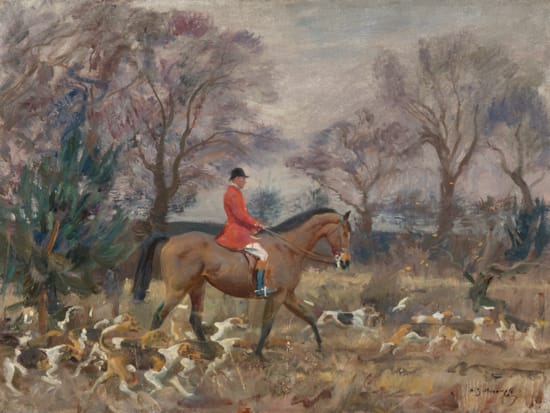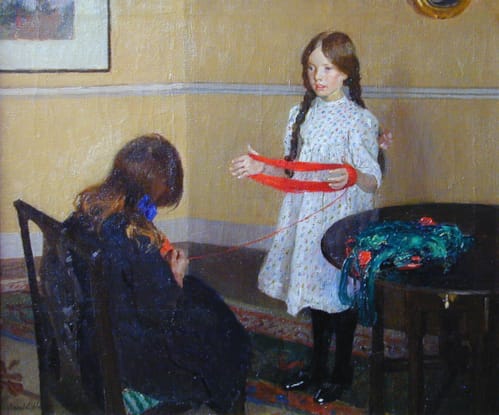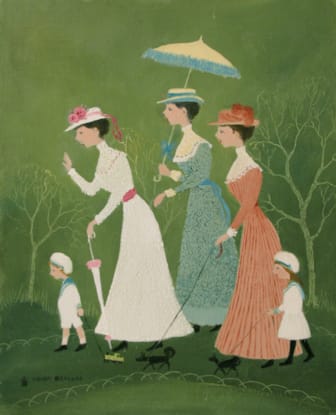Sir William Russell Flint, PPRWS, RA
(1880 - 1969)
The Twisted Chain, Cecilia
Signed, lower right: W. RUSSELL FLINT-;
also signed and inscribed, on the backboard:
The Twisted Chain/W Russell Flint
Watercolour on paper
14⅜ x 21⅜ in – 36.5 x 54.2 cm
Frame size
22¼ x 29 in – 56.5 x 73.7 cm
also signed and inscribed, on the backboard:
The Twisted Chain/W Russell Flint
Watercolour on paper
14⅜ x 21⅜ in – 36.5 x 54.2 cm
Frame size
22¼ x 29 in – 56.5 x 73.7 cm
Tel.: +44 (0)20 7839 7693
Provenance
Frost & Reed, London, where purchased by the family of the past owner;
Thence by descent;
Private collection, Buenos Aires, Argentina;
MacConnal-Mason Gallery, London, 2010;
Private collection, UK
Thence by descent;
Private collection, Buenos Aires, Argentina;
MacConnal-Mason Gallery, London, 2010;
Private collection, UK
Biography
Sir William Russell Flint is a world-renowned artist with works in Private and Public Collections throughout the UK and worldwide.
William Russell Flint was born 4th April 1880 in Edinburgh, the eldest son of Francis Wighton Flint, a commercial artist. Educated at Daniel Stewart College, Flint left school at 14 and was apprenticed to a firm of lithographers, Banks and Co, in Edinburgh as a draughtsman, and in 1895 began evening classes at the Royal Institution School of Art. In 1900 Flint moved to London, where he was initially employed as a medical illustrator and subsequently by the Illustrated London News from 1903-07, studying in the evenings at Heatherley’s School of Art. It was at the instigation of Thomas Heatherley that Flint devoted himself to watercolour and travelled to Paris exhibiting at the Salon de la Societé Nationale. Flint also visited Holland and Belgium in the company of his younger brother Robert Purves Flint (1883-1947) on a painting tour.
An enormously successful artist Flint first exhibited at the Royal Academy in 1906 and in Venice from 1909 to 1914 and this latter year exhibited in Berlin views of his travels in France and Italy 1912 to 1913. He was awarded a silver medal at the Paris Salon of 1912. At this same period Flint was commissioned to illustrate a number of classic editions, for among others Philip Lee Warner, including Thomas Mallory’s Morte D’Arthur and Chaucer’s Canterbury Tales.
During the First World War Flint served as a Lieutenant in the RNVR; his wife, Sybil, whom he married in 1905, was daughter of the Fleet Paymaster J. T. Seuter and sister of Admiral Sir Murray Seuter. Flint transferred to the RAF as a captain and served from 1918 to 1919 as Admiralty Assistant Overseer Airships. Following the war Flint returned full time to his career as an artist. He had been elected a member of the Royal Watercolour Society in 1917, and in 1924, after exhibiting only three oils, was elected Associate of the Royal Academy, receiving full membership in 1933 and later serving as a trustee 1943-55.
Flint had a significant following in the USA, he had exhibited at the Art Institute of Chicago in 1922, receiving the Purchase prize that year, and continued to exhibit in the States. With his success increasing, he and Sybil moved to Peel Cottage in Peel Street, Campden Hill in London where they were to remain.
In 1931 Flint was appointed a member of the Royal Society of Painters, Etchers and Engravers, having studied engraving at Hammersmith School of Art prior to the First World War. Flint served as President of the Royal Society of Painters in Watercolour 1936-56 and was knighted for his services to art in 1947.
In 1962 Flint was accorded the rare distinction, shared by only 5 other Royal Academicians, of being granted an exhibition of his work in the Diploma Galleries at the Royal Academy, a tribute to his status as one of the foremost British artists of the 20th century.
Flint’s success and lasting reputation lie in his extraordinary ability to portray the female form. Perhaps his best-known model was the ex-ballet dancer Cecilia Green his muse and confidante, who appears in numerous works by the artist over a period of fifteen years. Whether in oil, tempera or watercolour, in a career spanning 70 years his virtuoso technique allowed him to depict his vision of beauty.
His works can be found in museums in: Liverpool, Walker Art Gallery and London, Victoria and Albert Museum., Edinburgh, National Gallery of Scotland, Birmingham, Chicago, Winnipeg, Indianapolis.




